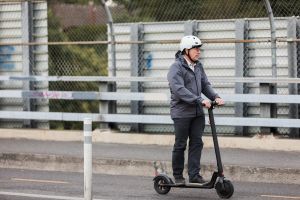A review of national and international e-scooter and micromobility trends outlines Chicago's 2019 pilot program and makes policy recommendations to improve sustainability, mobility, and equitable access.
Introduction
Shared electric scooters continue to excite and confound city governments worldwide. Since e-scooters first appeared in Santa Monica in 2017, cities have engaged in a trial-and-error policy process to reap the benefits, limit the costs, protect the public interest. Backers tout the devices as a solution to problems with global ramifications, a sustainable first- and last-mile solution that can remove cars from city streets. Others raise concerns about safety, clutter, equitable access, and environmental impact – and whether e-scooters can live up to companies’ lofty claims.
To settle these issues and others, Chicago initiated a four-month pilot on the city’s West Side beginning in June 2019. The pilot featured ten companies, and was structured to investigate how e-scooters could fit into Chicago’s transportation system. It paid special attention to implications for transportation equity, access, and mobility options.
The pilot generated new trip and operational data, but left certain big-picture questions unanswered. Mayor Lightfoot described the results as “mixed” – encouraging in that it appeared to shift some trips from car to e-scooter, but disappointing in the areas of storage, company compliance, and ridership demographics. As a result, the City recommended a second pilot in 2020 to further investigate how e-scooters can address lingering equity, clutter, and safety questions.
Chicago’s cautious approach reflects continued uncertainty about the larger social benefits and costs of e-scooters. Even as a second pilot promises clearer operational data, these bigger questions deserve their own investigation. To what extent should the City embrace the devices? How can Chicago approach a second pilot in ways that strengthen its overall mobility strategy?
With these questions in mind, this paper offers a national and international overview of the e-scooter and micro-mobility trends and outlines the 2019 pilot program in Chicago. It leaves aside operational and technical questions. Instead, it proposes strategic policy recommendations based on the City’s goals of improving sustainability, mobility, and equitable access.
A prudent yet ambitious policy approach would focus on achieving existing City transportation objectives, rather than merely accommodating new technology for its own sake.
Key Recommendations
- Embrace micromobility, not e-scooters specifically. Develop a Chicago micromobility strategy that reflects city goals. Invest in micrombility infrastructure, which can bring citywide environmental, congestion, and quality-of-life benefits, but let companies pay e-scooter-specific costs.
- Expand the second e-scooter pilot – in restricted form – to downtown Chicago. A useful pilot will test whether the devices can safely improve mobility in the city’s most congested areas.
- Don’t discount recreational trips. Analyze and consider how to plan for the large portion of “lap” trips.
- Continue to pursue solutions targeting safety, clutter, and sustainability. These concerns rightly remain a high priority for the City.
- Continue to prioritize equitable and affordable access. Chicago can learn from other cities to ensure companies make devices available and affordable to all.


